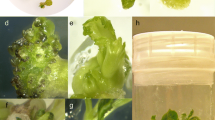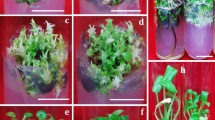Abstract
More than 5000 cultures, from 30 accessions of six Glycine species, were established to assess the rôle of plant genotype in the response to an agar-solidified culture medium containing B5 salts and vitamins, 3% w/v sucrose, 1.1 mg 1−1 BAP and 0.005 mg 1−1 IBA, already known to induce shoot regeneration in callus of G. clandestina. Shoot initiation was obtained in a variety of explants from G. canescens, G. falcata, G. latrobeana and G. tomentella. With the exception of G. latrobeana, development of buds into shoots followed transfer to B5-based medium with 0.2 mg−1 BAP and 0.005 mg 1−1 IBA. Shoots readily produced roots in hormone-free half-strength B5 medium. In G. latrobeana, both extension and rooting occurred on this medium. Shoot regeneration was obtained in 12 of 30 accessions evaluated, but one accession of G. canescens, G1171, produced shoots and plantlets at a consistently higher frequency than other accessions, with plantlet recovery in more than 70% of the cultures. Bud formation in callus of G. canescens G1171 also occurred if BAP was replaced by 1.0 mg 1−1 kinetin, 2i-p or zeatin, albeit at a lower frequency.
Similar content being viewed by others
References
Broué P, Douglass J, Grace JP, Marshall DR (1982) Interspecific hybridisation of soybeans and perennial Glycine species indigenous to Australia via embryo culture. Euphytica 31: 715–724.
Burdon JJ, Marshall DR (1981a) Evaluation of Australian native species of Glycine for resistance to soybean rust. Plant Disease 65: 44–45.
Burdon JJ, Marshall DR (1981b) Inter- and intra-specific diversity in the disease response for four Glycine species to the leaf rust fungus Phakopsora pachyrhizi. J Ecol 69: 381–390.
Gamborg OL, Miller RA, Ojima K (1968) Nutrient requirements of suspension cultures of soybean roots. Exp Cell Res 50: 151–158.
Grant JE (1984) Plant regeneration from cotyledonary tissue of Glycine canescens, a wild perennial relative of soybean. Plant Cell Tissue Org Cult 3: 169–173.
Grant JE (1986) Hybridisation of soybean with its diploid wild perennial relatives. Proc Plant Breed Symp, Lincoln NZ, Paper 35.
Hammatt N, Davey MR, Nelson RS (1986) Plant regeneration from seedling cotyledons, petioles and leaves of Glycine clandestina. Physiol Plant 68: 125: 128.
Hammatt N, Davey MR (1987) Somatic embryogenesis and plant regeneration from cultured zygotic embryos of soybean (Glycine max L. Merr.). J Plant Physiol (In Press).
Hammatt N, Kim H-I, Davey MR, Nelson RS, Cocking EC (1987) Plant regeneration from cotyledon protoplasts of Glycine canescens and G. clandestina. Plant Sci 48: 129–135.
Hymowitz T, Chalmers NL, Constanza SH, Saam MM (1986) Plant regeneration from leaf explants of Glycine clandestina Wendl. Plant Cell Rep 3: 192–194.
Kameya T, Widholm J (1981) Regeneration from hypocotyl sections of Glycine species. Plant Sci Leet 21: 289–294.
Marshall DR, Broué P (1981) The wild relatives of crop plants indigenous to Australia and their use in plant breeding. J Aust Inst Agric Sci 47: 149–154.
Mignucci JS, Chamberlain DW (1978) Interactions of Microsphaera diffusa with soybeans and other legumes. Phytopathology 68: 169–173.
Murashige T, Skoog F (1962) A revised medium for rapid growth and bioassays with tobacco tissue cultures. Physiol Plant 15: 473–497.
Newell CA, Hymowitz T (1982) Successful wide hybridisation between the soybean and a wild perennial relative, G. tomentella Hayata. Crop Sci 22: 1062–1065.
Newell CA, Luu HT (1985) Protoplast culture and plant regeneration in Glycine canescens F.J. Herm. Plant Cell Tiss Org Cult 4: 145–149.
Newell CA, Delannay X, Edge ME (1987) Interspecific hybrids between the soybean Glycine max (L.) Merr. and wild perennial relatives. J Heredity (in press).
Singh RJ, Hymowitz T (1985) An intersubgeneric hybrid between Glycine tomentella Hayata and the soybean, G. max (L.) Merr. Euphytica 34: 187–192.
Singh BB, Gupta SC, Singh BD (1974) Sources of field resistance to rust and yellow mosaic diseases soybean. Ind J Genet Plant Breed 34: 400–404.
Widholm JM, Rick S (1983) Shoot regeneration from Glycine canescens tissue cultures. Plant Cell Rep 2: 19–20.
Author information
Authors and Affiliations
Rights and permissions
About this article
Cite this article
Hammatt, N., Nelson, R.S. & Davey, M.R. Plant regeneration from seedling explants of perennial Glycine species. Plant Cell Tiss Organ Cult 11, 3–11 (1987). https://doi.org/10.1007/BF00036571
Received:
Accepted:
Issue Date:
DOI: https://doi.org/10.1007/BF00036571




